Lucet braiding is an ancient form of cord-making that is enjoyable, fast and fun for all. Make unique and useful products by sewing the cord into rugs, throws, chair pads, hats, bags, belts, drawstring or jewelry using yarn, string, thread and natural fibers.
The kit comes with the wooden hand lucet pre-started with yarn and instructions with digital images.
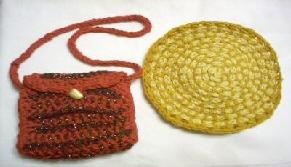

Lucet Braiding
The lucet is believed to date back to the Viking Era due to findings of manmade bone objects. Antlers were also used to make this tool. It was commonly used throughout the 1600's until the 1800's, when the manufacture of cording made it cheaper to buy.
In medieval and earlier times, it was used to make cording that laced clothing together, and to tie on armor. Aglets added to ends of the cording assisted in threading through ready made holes in armor and clothing, and kept ends from fraying.
The aglets of the wealthy were made from silver or gold and were sometimes decorated with precious jewels.
Bronze and brass were more affordable for commoners while imitating the decorations of the rich by substituting natural stones. Other uses for lucet cord included decorative trim and cords for jewelry.
Lucetor Tvinningsben of Viking Times
by Sandy Sempel-Frojel Gotlandica
Most of the Anglo-Scandinavian lucets found at York appear to have been crafted from a cow nasal bone, which naturally has the general shape seen here. The Swedish example appears to be made from a long bone, perhaps a leg bone, and utilizes the natural hollow in the middle."
In 1968 Kerstin Pettersson wrote an article in TOR (vol XII) on a find of a Womans burial from Barshalder, Gr"tlingbo parish, Gotland. Among the rich textile finds from the grave are two braided cords. They are both square in section and roughly 3-4 mm and 1,5-2 mm across. The latter was found corroded to the needles in two of the four animal-head brooches in the grave. (Pettersson K. "En gotl"ndsk boneskvinnas dr"kt. Kring ett textilfynd fr+n vikingatiden" p. 174 - 200, TOR XII, 197-68. B. Almgren & I. H"gg (ed) Stockholm 1968) Eketorp-III
Experiments show that a tool with two points, called a Tvinningsben (meaning string twisting), gave a result close to the original cord (more than 250 artifact tools have been found, some if which are pointed needles). Pages 153-154, the Tvinningsben (ten of which have been found) on pages 156-157.
They are described as twining bones used for making coarse yarns and cords.
They have also been found at Lund, Sigtuna, L"ddek"pinge, Gotland and Falsterbohus
as well. Very few have any real decoration, they are mostly made from Sheep metatarsus and metacarpus and are a disposable tool.
These tools are known by several Scandinavian names, Tvinningsben being one. The lucette, (a name from latet French ), is a smooth multi-pronged implement; more commonly having two prongs, sometiomes four or more. Most archaeological finds from the Viking age have been bone or horn but any suitable material can be used.
Jorvik site - York, England
Lucet or twining bone thought to be made from cow nasal bone.
Skane, Sweden
Sheep leg bone lucet inscribed with runes.
Hossmo Church - Kalmar County, Sweden
Bronze lucet 3" L
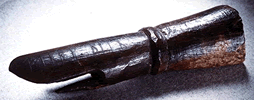


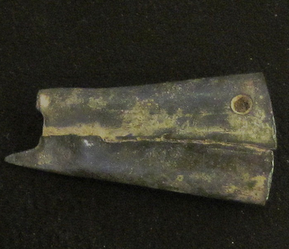
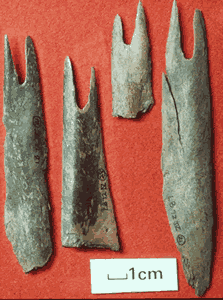

For more information on the Viking history visit: https://www.livescience.com/viking-history-facts-myths
Brass Aglets - Fl Museum of Nat. Hist.
Columbus documented brass aglets were being traded to Cuba for gold.
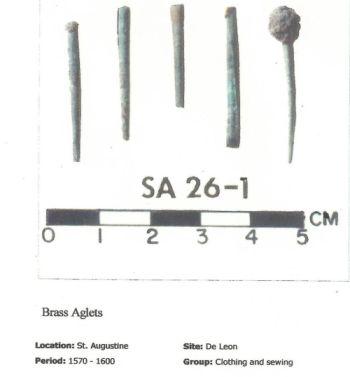

Sci/Tech
Humble shoelace tag carried more currency than gold on Columbus's travels
Author: University College London
Published on Oct 3, 2006 - 7:59:00 AM
The humble device that prevents shoelaces from fraying was deemed to be worth more than gold by the indigenous Cubans who traded with Columbus's fleet, a study led by UCL (University College London) archaeologists has discovered.
Reporting in next month's edition of the Journal of Archaeological Science, the researchers analysed burial material – such as beads and pendants – excavated from one of the largest burial sites in northeast Cuba. To their surprise very little gold was discovered, despite its relative abundance in the region. Instead, the most common artefacts were small metal tubes made of brass that were often threaded into necklaces.
While brass making was widespread in medieval and earlier Europe, no evidence exists of brass production in America by indigenous people in the Caribbean – known as Taíno – before the arrival of the Europeans. Using microstructural and chemical analysis, the researchers were able to prove the brass originated in Germany.
Columbus's 1492 Spanish fleet was the first European presence to arrive in Cuba and radiocarbon dating shows remains from the burial site at El Chorro de Maíta, Cuba date from a few decades after the conquest. Columbus's diaries also mention the trade of lacetags.
A review of relevant literature and paintings from European sources revealed that the most likely origin of the tubes was not beads but strung together lacetags, or aglets, from European clothing. From the 15th century onwards, these were used to prevent the ends of laces from fraying, and to ease threading in the points for fastening clothes such as doublets and hose. Examples of such usage include a 1636 portrait of William Style of Langley (Tate Gallery, London), which depicts the use of aglets in his waist to secure his trousers through his jacket. Original lacetags excavated from across London that date back to the 13th century can also be found in the Museum of London's Archaeological Archive.
Dr Marcos Martinón-Torres, of the UCL Institute of Archaeology, who led the research, explains: "Early chroniclers report that pure gold, or caona, was considered the least valuable metal amongst indigenous Cubans, significantly less esteemed and less sacred than copper-based alloys. Allegedly, the smell and iridescence of brass was what made it particularly appealing. If we couple this with the contrasting eagerness of the Spanish for plundering noble metals, then we have a paramount factor explaining the scarcity of gold in the cemetery at El Chorro de Maíta, and the relative abundance of brass.
"It would have been impossible for the first Europeans arriving in the Caribbean to envisage the colossal value that their metal would accomplish in trade with the indigenous population. Accordingly, one could not expect them to have loaded up their ships with unnecessarily large amounts of metals. Upon arrival, with virtually any metal gadget becoming precious amongst the Taíno, European conquerors would have traded anything they had at hand, including the cheap and dispensable lacetags. Moreover, these had a suitable shape for threading and turning into visible pendants. Functional European brass was thus conceptually transformed, not only, into an ornament but it conveyed supernatural powers to the wearer."
Located in the Banes area of the Holguín province, El Chorro de Maíta